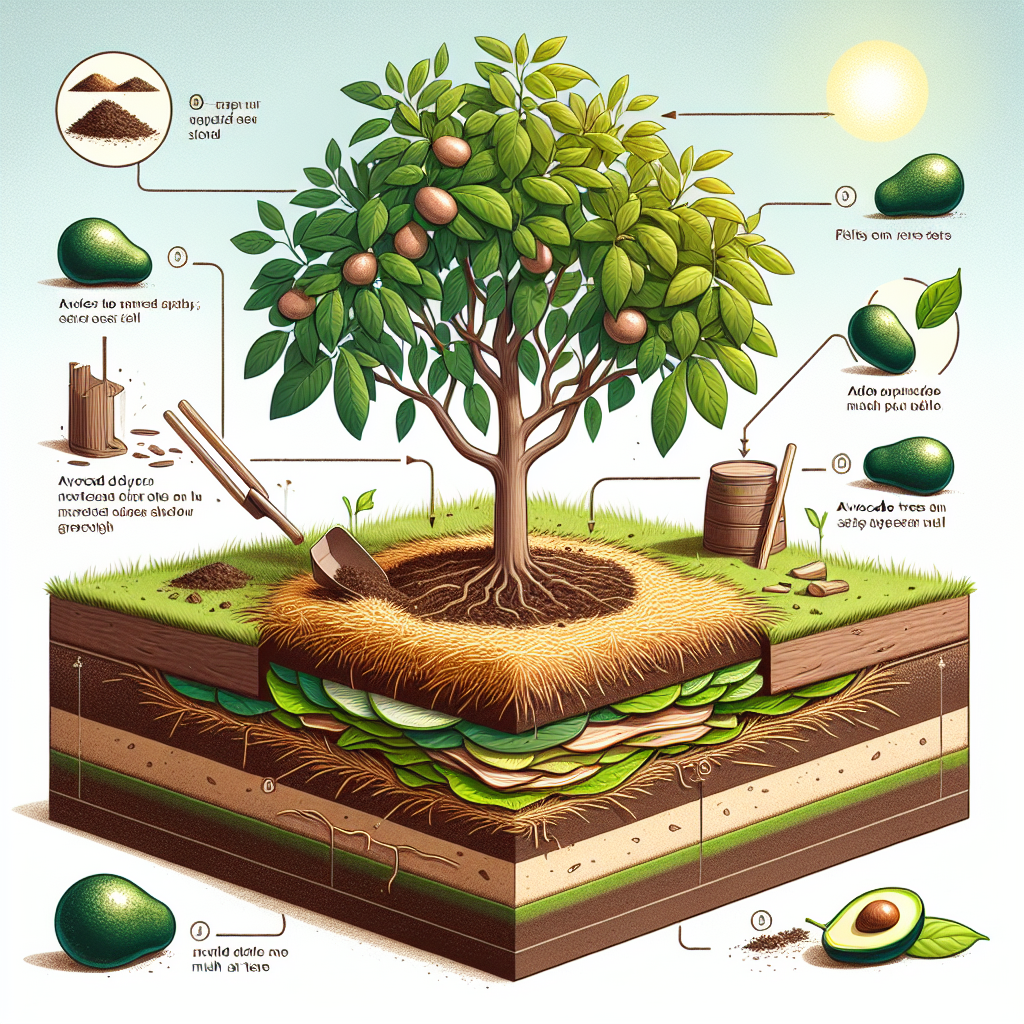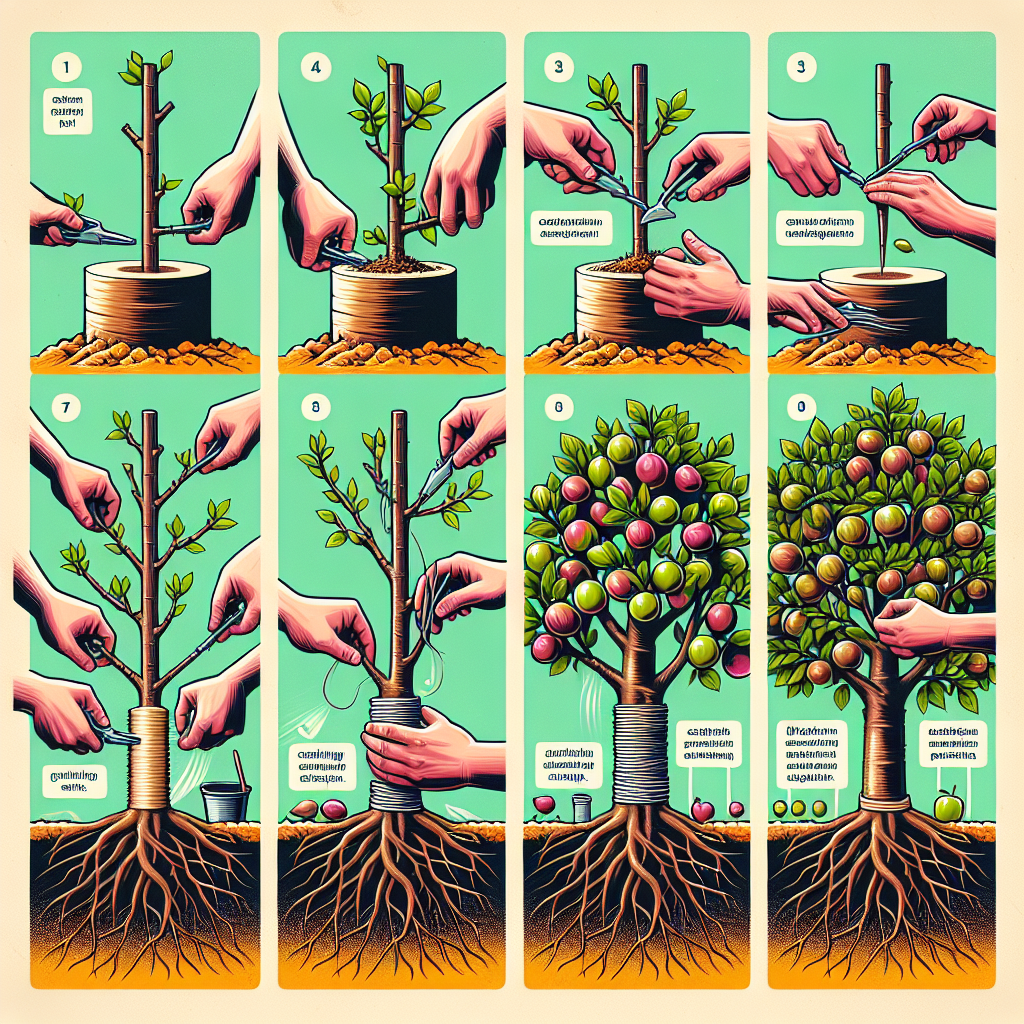Effective Mulching for Avocado Trees
Published January 13, 2024 at 7:04 pm

Understanding Mulching for Avocado Trees
If youre passionate about nurturing avocado trees in your garden, then understanding the role of mulching is crucial. Its like giving your trees a cozy blanket that keeps them comfortable year-round. Mulching not only retains moisture during those scorching summer days but it also prevents weed growth and gradually enriches the soil as it decomposes.
Beyond just throwing any mulch down, its about choosing the right type and applying it properly. Let’s delve into this gardening practice that might just be the game-changer for your avocado trees.
- Pet Friendly – Most natural mulches are pet-friendly, but always double-check for cocoa mulch which can be harmful to pets.
- Light Requirements – Mulching does not affect the light requirements of an avocado tree directly, but a properly mulched tree can better handle light variations.
- Watering – A well-mulched avocado tree typically requires less frequent watering as the mulch helps retain soil moisture.
- Humidity – By retaining moisture at the soil level, mulch can help to maintain a microclimate with higher humidity around the tree.
- Temperature – Mulch acts as an insulator to protect avocado tree roots from extreme temperatures, both hot and cold.
- Difficulty – Mulching is a relatively straightforward process that can bring tremendous benefits with proper application.
Selecting the Best Mulch for Avocado Trees
Going mulch-shopping can be a bit overwhelming with all the choices available. When it comes to avocado trees, organic mulches such as straw, pine needles, or wood chips are often recommended. They break down over time, adding nutrients back into the soil.
Remember that avocados thrive in well-drained soils, and using organic mulches enhances soil structure and fertility over time. You might encounter mulches like rubber or rocks, but these won’t enrich your soil like organic options do.
How Much Mulch Do You Need?
Its like Goldilocks, you need to get the amount of mulch just right. For avocado trees, spread a 2 to 4-inch layer. Too little wont be effective in retaining moisture or suppressing weeds, and too much might suffocate your trees roots.
Be careful not to pile mulch against the trunk directly, as this can lead to rot. Keep it a few inches away to allow the base of the tree to breathe.
When to Mulch Avocado Trees
Timing can make all the difference. The best time to mulch avocado trees is in the early spring or late fall. This allows the mulch to protect the soil from temperature extremes and to maintain moisture during the growing season.
If you notice the mulch breaking down or notice soil exposure, it’s a good sign it’s time to replenish. Checking the mulch thickness once or twice a year should suffice for the health and happiness of your avocado trees.
Review of a Top Mulch for Avocado Trees: Wood Chips
Wood chips are a popular mulch choice for avocado trees, and for good reason. They are widely available and typically inexpensive, sometimes even free from local arborists. Wood chips break down slowly, providing a long-lasting layer of protection for the soil.
Reviews often highlight how wood chips help to maintain soil moisture even during hot spells, which is vital for avocado trees. They also tend to stay in place better than lighter mulches, reducing the need for frequent top-ups.
Pros
- Improves soil structure as it decomposes
- Retains moisture effectively
- Suppresses weed growth
Cons
- Can attract pests if not sourced from a reliable supplier
- May take nitrogen from the soil initially as they decompose
- Heavier and harder to spread than some other mulch types
Find This and More on Amazon
The Importance of Proper Mulch Application
Applying mulch around avocado trees isn’t just about dumping a bag of wood chips and calling it a day. Proper application is critical for preventing disease and ensuring your tree’s health. Start by spreading mulch evenly around the base, avoiding direct contact with the trunk, as mentioned earlier.
Furthermore, do not overlook the importance of replenishing mulch periodically. As mulch decomposes, it feeds the soil, but this also means it reduces in volume and its effectiveness can wane. Observing this cycle and maintaining a consistent mulch layer can make a substantial difference.
Irrigation Considerations with Mulched Avocado Trees
While a benefit of mulch is reduced watering frequency, this doesn’t mean you can forget about monitoring moisture levels. Use a soil moisture meter to check if your watering schedule is adequate. Moisture meters are simple tools that give you a clearer idea about when it’s time to water.
Insert the probe into the soil, avoiding the mulch layer to get an accurate reading. Users often praise moisture meters for taking the guesswork out of watering, especially in mulched gardens where visual cues are less obvious.
Mulch and Pests: Maintaining a Balance
While mulch is beneficial, it can also create habitat for pests. An infestation could spell trouble for your avocado trees. However, don’t let this deter you from using mulch—regular maintenance and observation can keep pests at bay.
Be on the lookout for signs of unwanted critters and consider integrated pest management practices. This could include using beneficial insects or organic pest repellents to protect your garden without resorting to harsh chemicals.
Complementary Products for Mulching: Soil Moisture Meters
As we’ve started to touch on the usefulness of soil moisture meters, let’s dive deeper. The Dr.meter Soil Moisture Sensor Meter is a product with favorable reviews for its accuracy and durability. It requires no battery and is easy to read, which is great for any gardener looking to simplify their plant care routine.
This tool is especially useful in the context of mulching, as it helps you avoid the common issue of overwatering, which can cause root rot in avocado trees. By measuring moisture directly within the root zone, you can more effectively gauge when it’s time to water your mulched avocado tree.
Pros
- Accuracy in measuring soil moisture levels
- No battery required and simple to use
- Durable and long-lasting design
Cons
- Limited to moisture readings; doesn’t measure light or pH
- Must be handled carefully to avoid damage to the probe
- Not suitable for rocky soil or soils with high clay content
Find This and More on Amazon
The Environmental Benefits of Mulching
When you opt to mulch, you aren’t just helping your avocado tree; you’re also contributing to a healthier environment. Organic mulches like wood chips are carbon-based and can help capture from the atmosphere, contributing to carbon sequestration in the soil.
Moreover, mulching can significantly reduce water evaporation from the soil, leading to less water use and conservation of a vital resource. Emphasizing environmental sustainability, mulching aligns with eco-friendly gardening practices that many are eager to adopt.
Best Practices to Avoid Common Mulching Mistakes
Even experienced gardeners can fall victim to common mulching errors. One of the most frequent missteps is “volcano mulching,” where mulch is piled high around the base of the tree creating a volcano-like shape. This traps moisture against the trunk and can introduce rot or disease.
Avoid this pitfall by spreading the mulch evenly, starting a few inches away from the base and extending outwards to the drip line—the area directly below the outer circumference of the tree branches. This technique promotes better air circulation and more efficient delivery of nutrients to the roots.
Understanding Mulch Types and Their Decomposition Rates
Not all mulches are created equal, and they decompose at varying rates. Wood chips, for example, break down slower than straw, which means they don’t need to be replaced as often but also take longer to contribute nutrients back to the soil.
If you’re seeking quicker soil enhancement, you might consider a finer organic mulch like compost or aged sawdust. These types break down faster, but they need to be reapplied more frequently to maintain their benefits. It’s a trade-off between longevity and nutrient turnover that you’ll want to consider based on your gardening goals.
Maintaining the Right Mulch Depth
Consistent with our earlier mention of ‘Goldilocks’ mulching, maintaining the right depth is imperative. Over time, natural elements and garden activity can disrupt the mulch layer, leaving some areas too thin and others too thick.
Periodically rake through the mulch to ensure an even distribution and refresh areas that have compacted or dispersed. This also helps uncover any issues, such as fungal growth or pest activity, that may be developing beneath the surface.
Recap: The Ultimate Guide to Mulching for Avocado Trees
To wrap up, mulching your avocado trees isn’t just a set-and-forget gardening task. It requires thoughtful consideration from selection to application, and ongoing maintenance. Invest in the right organic mulch, apply it with care, and pay attention to how it interacts with your watering and garden environment.
Remember to choose mulches that will add to the soil quality as they decompose, like wood chips, and steer clear of non-organic options like rubber. Look out for pest invasions, maintain proper moisture levels, and avoid piling mulch high against the trunk. With these practices, your avocado trees should thrive, providing you with lush growth and perhaps even some delicious avocados to enjoy.
Mulching and Avocado Tree Health: A Harmonious Relationship
Mulching does more than just conserve water and suppress weeds—it plays a substantial role in the overall health of your avocado trees. A healthy layer of mulch can prevent soil compaction, which allows roots to receive adequate oxygen, promoting vigorous growth.
Organic mulches also act as a slow-release fertilizer. As they decompose, they provide essential nutrients to the trees, fostering a fertile environment for avocados to flourish. Monitoring and maintaining your mulch ensures a symbiotic relationship between the mulch and your avocado trees’ health.
Expert Tips on Refreshing Mulch for Optimal Results
Refreshing mulch around your avocado trees is akin to refreshing the bed linens: it’s all about timing and technique. You’ll want to add new mulch before the old layer has fully broken down, ideally once a year, to ensure there’s always a protective layer in place.
Avoid completely removing the old mulch, as it’s already started enriching the soil. Instead, integrate new mulch into the existing layer to enhance its benefits. This approach maintains a consistent level of mulch while boosting soil health over time.
Maximizing Mulch Benefits During Dry Spells
During extended dry periods, mulch can be a lifesaver for your avocado trees. By significantly reducing the evaporation rate, a proper mulch layer ensures that your trees’ roots have access to moisture even when rain is scarce.
Consider adding a slightly thicker layer of mulch before a forecasted drought to provide extra insulation against the dry conditions. This proactive step can make a big difference in the health and stress levels of your avocado trees.
Exploring Alternative Mulching Materials
While wood chips are an excellent mulching option for avocado trees, there are other materials worth considering. For instance, leaf mold, created from decomposed leaves, can offer a nutrient-rich layer with a fine texture.
Another alternative is composted garden waste, which not only disposes of your yard trimmings sustainably but also adds a wealth of microorganisms and nutrients to the soil. Each material comes with its own set of advantages, and diversifying your mulch choices could benefit soil health and biodiversity.
Combating Mulch-Borne Diseases
Though rare, mulch can sometimes harbor diseases that could potentially harm your avocado trees. To minimize this risk, source your mulch from reputable suppliers and avoid using mulch that looks or smells off.
If you’re composting at home, make sure the compost reaches a high enough temperature to kill off any pathogens before applying it as mulch. A good rule of thumb is to turn your compost regularly to facilitate the breakdown process and prevent the development of disease vectors.
Visual Appeal and Mulching: Enhancing Your Garden’s Aesthetics
Mulching isn’t only about practical benefits. The right mulch can also elevate the visual appeal of your garden, creating a clean, unified look around your avocado trees. Dark, rich mulches like well-rotted compost can contrast beautifully with the lush green foliage, highlighting your garden’s natural beauty.
Choose a mulch color and texture that complements your landscape design. This not only serves your avocado trees’ needs but also turns your functional garden space into an exquisite visual sanctuary.
Local Climate and Choosing the Right Mulch
The climate you live in can influence the type of mulch that’s best for your avocado trees. In wetter climates, you might opt for a coarser mulch that improves drainage and reduces the chance of root rot.
Conversely, in arid regions, a finer, denser mulch could be more beneficial for retaining moisture. Understanding your local environment and selecting the appropriate mulch will ensure that you’re bolstering your avocado trees’ health in the most efficient method possible.
Cost-Effective Mulching Strategies
Mulching doesn’t have to break the bank. Many communities offer free mulch programs where you can get wood chips or compost generated from local tree trimming and yard waste recycling. Additionally, creating your own compost from kitchen and garden scraps is a sustainable and economical way to produce mulch.
By utilizing these resources, you’re not only saving on gardening expenses but also contributing to the reduction of waste within your community—an eco-friendly and wallet-conscious approach to mulching.
Proper Mulching as a Long-Term Investment
Approach mulching as a long-term investment for your avocado trees. It’s about more than short-term aesthetics or weed control—it’s about fostering an environment where your trees can thrive for years to come.
With the right selection, application, and maintenance of mulch, you’re investing in the soil’s fertility, your trees’ health, and ultimately, the productivity of your avocado grove. Your patience and diligence will be rewarded with hearty growth and bountiful harvests.
Mulch and the Bigger Picture: Integrating into Your Garden’s Ecosystem
Effective mulching is more than a gardening tactic; it’s a way to integrate your avocado trees into the broader ecosystem of your garden. By selecting organic mulches, you’re supporting the soil’s biodiversity, encouraging worms and beneficial insects, and creating a vibrant, self-sustaining garden environment.
Your mulch choice can have far-reaching effects, influencing everything from water conservation to wildlife habitat. Embrace mulch as a tool to not only protect and nourish your avocado trees but also to enhance the overall ecosystem of your garden.
.
Shop more on Amazon

